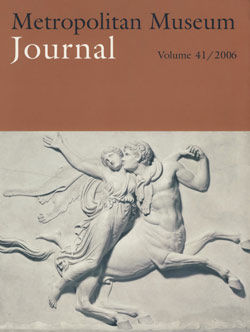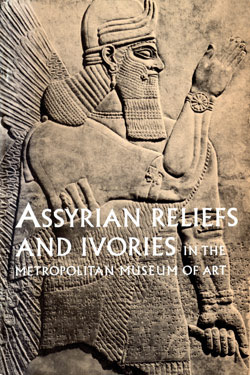Relief panel
Not on view
This panel from the Northwest Palace at Nimrud (ancient Kalhu) depicts a winged supernatural figure. Such figures appear throughout the palace, sometimes flanking either the figure of the Assyrian king or a stylized "sacred tree." The reliefs were painted, but today almost none of the original pigment survives. However, the reliefs themselves retain incredible detail, including intricate incised designs on many of the figures’ clothing.
This example shows a winged human-headed figure holding a small bucket in his left hand. Often figures with such buckets hold in their other hand a cone, called by the Assyrians a "purifier," but in this case the right hand is instead empty and raised in a beneficent gesture. The lower part of the bucket is decorated with the scale pattern used in Mesopotamian art to signify mountains and hilly terrain. The figure wears a diadem and bracelets adorned with rosettes, as well as armbands, a necklace of beads, and large pendant earrings. The rosette of the diadem is probably conceived of as centered on the figure’s forehead, but its position has been adjusted to allow the artists to show it as complete. He wears an embroidered tunic with long tassels and a fringed shawl, emerging from which at chest level can be seen the decorated handles of two knives. The exposed lower leg with exaggerated musculature is seen in many Assyrian and Babylonian depictions of divine and heroic figures.
An unusual feature of this relief is the square hollow carved in its left side. This was cut in antiquity, and the Standard Inscription running across the center of the panel is interrupted to take account of it. The original location of the relief at the beginning of a narrow space at one end of a room suggests that the hole may have been made to accommodate the end of a beam barring a door.
The figures are supernatural but do not represent any of the great gods. Rather, they are part of the vast supernatural population that for ancient Mesopotamians animated every aspect of the world. They appear as either eagle-headed or human-headed and wear a horned crown to indicate divinity. Both types of figure usually have wings. Because of their resemblance to groups of figurines buried under doorways for protection whose identities are known through ritual texts, it has been suggested that the figures in the palace reliefs represent the apkallu, wise sages from the distant past. This may indeed be one level of their symbolism, but protective figures of this kind are likely to have held multiple meanings and mythological connections.
Figures such as these continued to be depicted in later Assyrian palaces, though less frequently. Only in the Northwest Palace do they form such a dominant feature of the relief program. Also unique to the Northwest Palace is the so-called Standard Inscription that ran across the middle of every relief, often cutting across the imagery. The inscription, carved in cuneiform script and written in the Assyrian dialect of the Akkadian language, lists the achievements of Ashurnasirpal II (r. 883–859 B.C.), the builder of the palace. After giving his ancestry and royal titles, the Standard Inscription describes Ashurnasirpal’s successful military campaigns to east and west and his building works at Nimrud, most importantly the construction of the palace itself. The inscription is thought to have had a magical function, contributing to the divine protection of the king and the palace.
Due to rights restrictions, this image cannot be enlarged, viewed at full screen, or downloaded.



